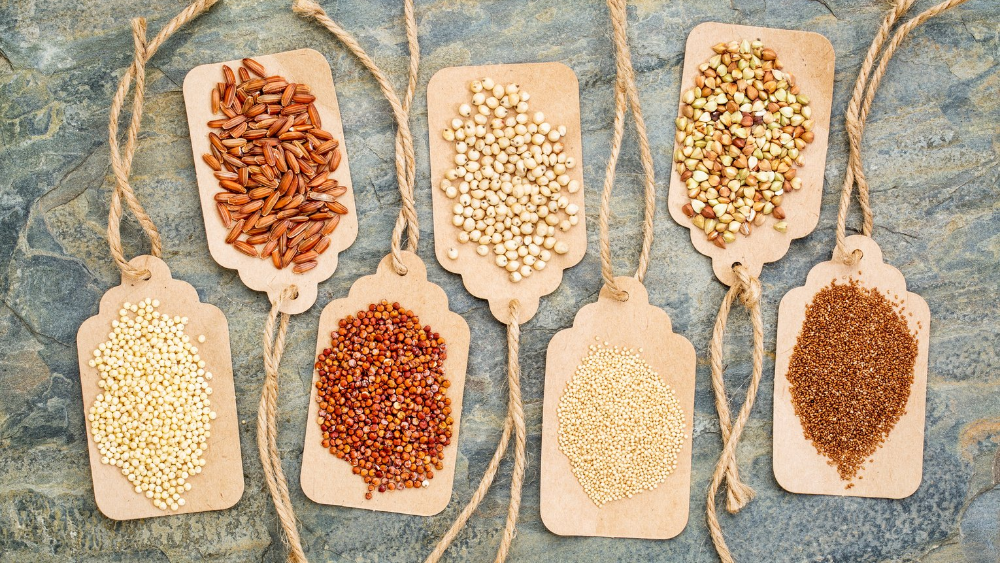An edited version of this article was published in the Summer 2021 Coeliac Link (official magazine of Coeliac New Zealand).
The relative abundance of gluten-free food in today’s supermarkets makes it easier than ever to find substitutes for our pre-diagnosis favourites. But although this variety means we can consider our brand, taste and price-point preferences along with the gluten-free status when we purchase, what about nutrition?
At face value, shopping for healthy gluten-free foods doesn’t seem any different to shopping for gluten-containing ones. We know we should avoid processed, packaged products as much as possible and eat plenty of fresh fruit and vegetables. We understand that chips and chocolate bars aren’t sensible everyday choices, regardless of their gluten content. However, delve a little deeper and it becomes clear that many even supposedly healthy gluten-free substitutes aren’t nutritionally equal to their counterparts.
How are the properties of wheat replicated?
Wheat is a phenomenal ingredient. Its high levels of the sticky, stretchy, strong gluten protein are almost impossible to mimic. It’s high in iron compared to the gluten-free flours commonly chosen by manufacturers and, as a whole grain, it contains a good amount of fibre. To replicate the taste, texture and shelf life of wheat-based foods, manufacturers often select low-fibre refined flours and starches, then add fat, sugar, salt, gums, cellulose, modified starches, emulsifiers and/or enzymes. The resulting gluten-free breads, pastas, crackers and so on may taste and feel like the real thing, but they’re often nutritionally inferior.
More fat, sugar, sodium and additives
Gluten-free processed foods tend to contain more fat, sugar, sodium and additives, and less protein, fibre and iron1. They often have a higher glycaemic index. About 30% of the iron in a typical gluten-consuming New Zealand diet comes from core cereal foods2, and yet gluten-free foods are also less often fortified with minerals and vitamins. The lower nutritional value of everyday gluten-free cereal-based products can often explain why some people gain weight, struggle to achieve sustained energy/satiety, and suffer from constipation and low iron on a gluten-free diet.
Knowledge is power
As always, knowledge is power, and once you’re armed with it, you can make better decisions to maximise your health and that of your children. Here’s how:
- Skip processed, packaged gluten-free food and fill up on naturally gluten-free ones.
- It’s easy to get bored and reach for the biscuits if you choose the same fruit and vegetables each week, so keep it interesting by widening the variety you buy. For a fibre boost, leave the skin on whenever you can.
- Fill children up on healthy, high-fibre snacks like popcorn, frozen raspberries/peas, carrot sticks, apple, roasted chickpeas and seeds.
- Broaden the kinds of gluten-free grains you and your children eat by looking for products that include quinoa, millet, brown rice, buckwheat, teff and amaranth.
- When it comes to gluten-free bread, take the time to compare the nutrition panel of different brands. Consider how the protein, fibre, fat and sodium (salt) stack up. If a bread is low-protein, top it with something that’s high in protein, such as hummus, egg, cheese or meat.
- Avoid the additives in supermarket baked goods by baking your own at home, but try not to rely solely on white rice, tapioca starch and cornflour-based pre-mixes. Substituting even quarter of the amount of flour a recipe requires with buckwheat, brown rice, chickpea or a nut flour will provide health benefits.
- Experiment with pasta that’s been made from pulses or wholegrains. It’s generally higher in fibre, protein and vitamins/minerals that standard gluten-free pasta.
- Choose breakfast cereals that are high in fibre and have been fortified with vitamins and minerals, such as iron, folate, niacin, thiamin and riboflavin.
- Take note of added ingredients in packaged products. If there are lots of numbers or ingredients you can’t pronounce, then you may be best to swap to a different brand or make it yourself.
The bottom line? Just because a gluten-free version of a food exists, doesn’t mean you should be eating it. Sometimes they’re simply not the same, – taste, price or health-wise.
References:
- https://www.ncbi.nlm.nih.gov/pmc/articles/PMC6213115/
- https://www.health.govt.nz/system/files/documents/publications/a-focus-on-nutrition-v2.pdf
Need personalised nutrition advice?
Elly McKenzie is a New Zealand-based nutritionist specialising in practical, evidence-based support for gut health, coeliac disease, irritable bowel syndrome, food allergies/intolerances, and general nutrition (including healthy eating, high cholesterol/blood pressure and pre-diabetes).
Consultations are available in person at her Mount Maunganui clinic (Tauranga) or across Aotearoa via secure Telehealth. Book a consultation or get in touch to learn more.

